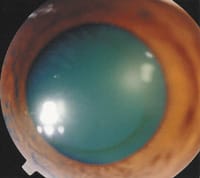orthokeratology today
Iron Deposition Rings: Now You See Them...Now You
Don't
BY MARJORIE J. RAH, OD, PHD
Several reports have appeared in the literature regarding the appearance of corneal pigmentation rings (Figure 1) following corneal reshaping. The appearance of the pigmentation is similar to iron deposition that can occur in keratoconus (Fleischer's Ring) or following corneal refractive surgery. Although researchers haven't conducted histological studies, experts presume that the pigmentation results from iron deposition in the basal epithelial layer of the cornea. The rings don't result in any serious visual consequences of which we're aware; however, they're of interest in further study of corneal physiology changes associated with overnight contact lens corneal reshaping.
|
|
|
|
Figure 1. A corneal pigmentation ring resulting from corneal
reshaping. |
Vanishing Rings
We've no doubt that this phenomenon occurs. But what happens when a patient who has developed pigment rings during contact lens corneal reshaping decides to discontinue treatment? If the pigmentation results from the change in corneal curvature following corneal reshaping, then experts hypothesize that when we discontinue treatment, the corneal shape would return to baseline and the pigmentation would resolve as the epithelial cells regenerate.
Cho et al (2003) reported two cases in which the pigment rings did in fact resolve. In her report, the rings appeared after one week of lens wear in one eye for one patient, but didn't appear until six weeks later in the opposite eye. In the case of the second patient, the rings first appeared after 28 weeks of lens wear. Two months after the patients chose to discontinue treatment, the pigment rings were no longer visible. Unfortunately, we don't know at what point the pigment deposition resolved in these two patients.
Watching them Disappear
I've recently had the opportunity to follow this phenomenon more closely. A patient of mine decided after three-and-a-half years of corneal reshaping treatment to discontinue treatment to pursue the option of refractive surgery. The pigment rings were evident in this patient, and we first noticed them following approximately one year of lens wear. They may have developed sooner, as his previous visit had been six months prior.
I've examined the patient on a weekly basis since discontinuation of treatment. After six weeks, the pigmented ring has faded but hasn't completely resolved. Perhaps the time necessary for the rings to resolve is associated with the length of time the patient had undergone corneal reshaping treatment. (That information isn't currently available.)
I do know that seeing is believing, and I expect to see the rings fully resolve in this patient. It'll just take longer than six weeks to occur. Based on the report by Cho et al, I expect complete resolution of the rings to occur some time over the next two weeks to a month.
To obtain references for this article, please visit http://www.clspectrum.com/references.asp and click on document #113.
Dr. Rah is an assistant professor at the New England College of Optometry where she works primarily in the Cornea and Contact Lens Service in patient care, teaching and research.




